Economic, Environmental, and Social Impacts of University Development
VerifiedAdded on 2023/06/13
|8
|2616
|196
Report
AI Summary
This report examines the multifaceted impacts of establishing a university, focusing on economic, environmental, and social dimensions. Economically, the report highlights job creation during construction and operation, costs involved in setting up the university, and revenue generation opportunities through professional training and facility rentals. Environmentally, it discusses the university's carbon footprint, sustainable building designs, and the environmental impact of construction, emphasizing the importance of reducing emissions and adopting sustainable practices. Socially, the report explores demographic changes, increased educational opportunities, and health and safety considerations, noting the role of universities in community development and providing essential services. The report concludes with recommendations for revenue generation, use of sustainable resources, and implementation of health and safety measures to maximize the positive impacts of the university while minimizing negative consequences. Desklib offers a wealth of similar academic resources to aid students in their studies.
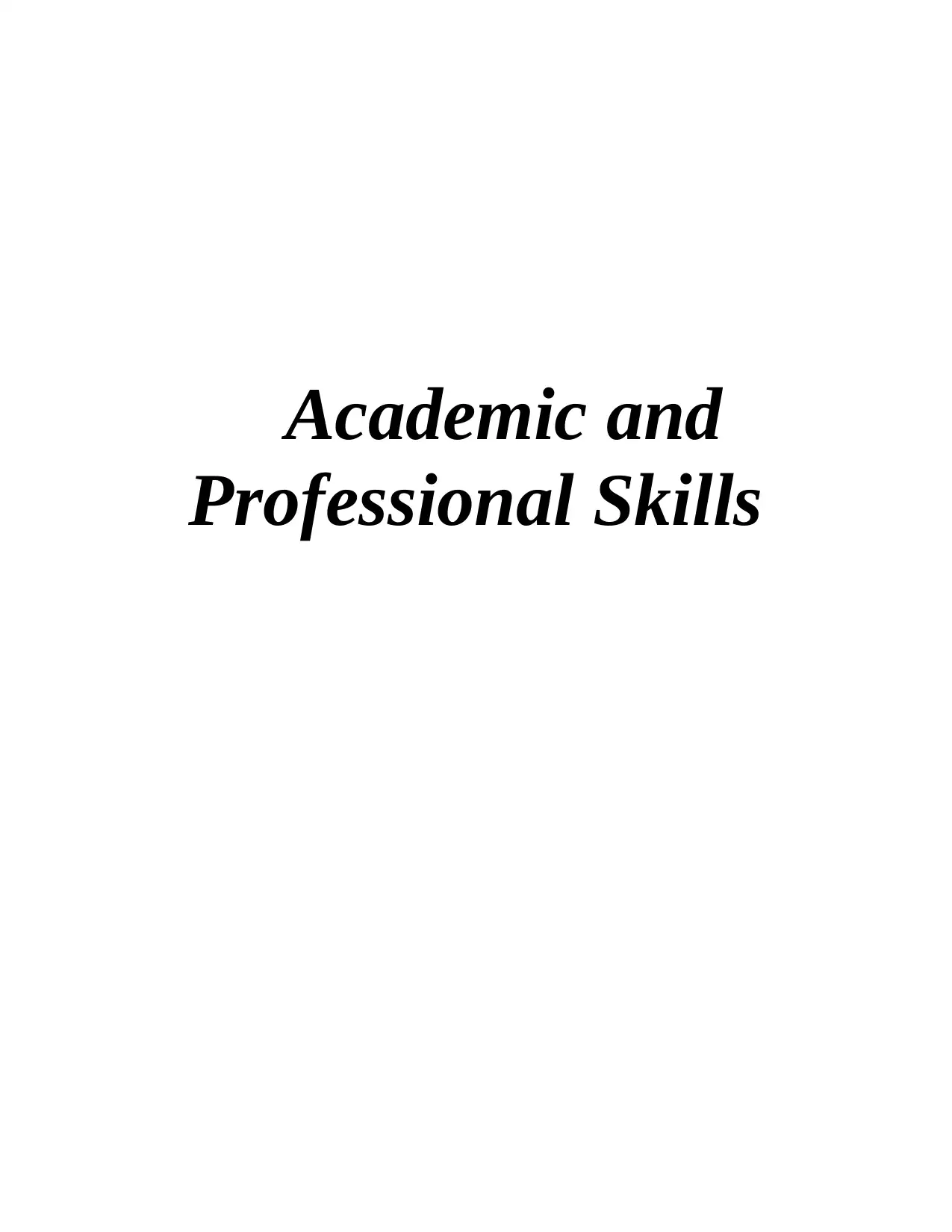
Academic and
Professional Skills
Professional Skills
Paraphrase This Document
Need a fresh take? Get an instant paraphrase of this document with our AI Paraphraser
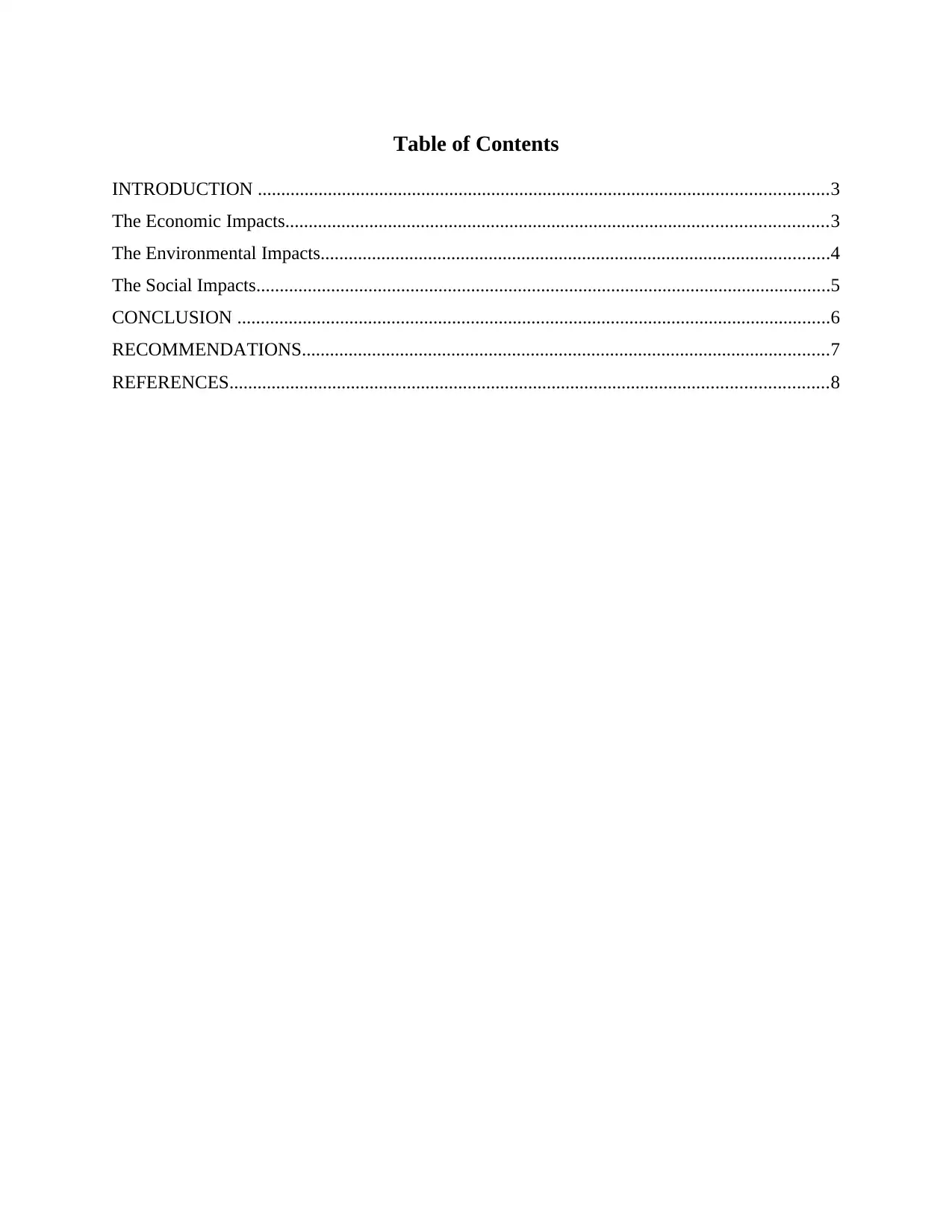
Table of Contents
INTRODUCTION ..........................................................................................................................3
The Economic Impacts....................................................................................................................3
The Environmental Impacts.............................................................................................................4
The Social Impacts...........................................................................................................................5
CONCLUSION ...............................................................................................................................6
RECOMMENDATIONS.................................................................................................................7
REFERENCES................................................................................................................................8
INTRODUCTION ..........................................................................................................................3
The Economic Impacts....................................................................................................................3
The Environmental Impacts.............................................................................................................4
The Social Impacts...........................................................................................................................5
CONCLUSION ...............................................................................................................................6
RECOMMENDATIONS.................................................................................................................7
REFERENCES................................................................................................................................8
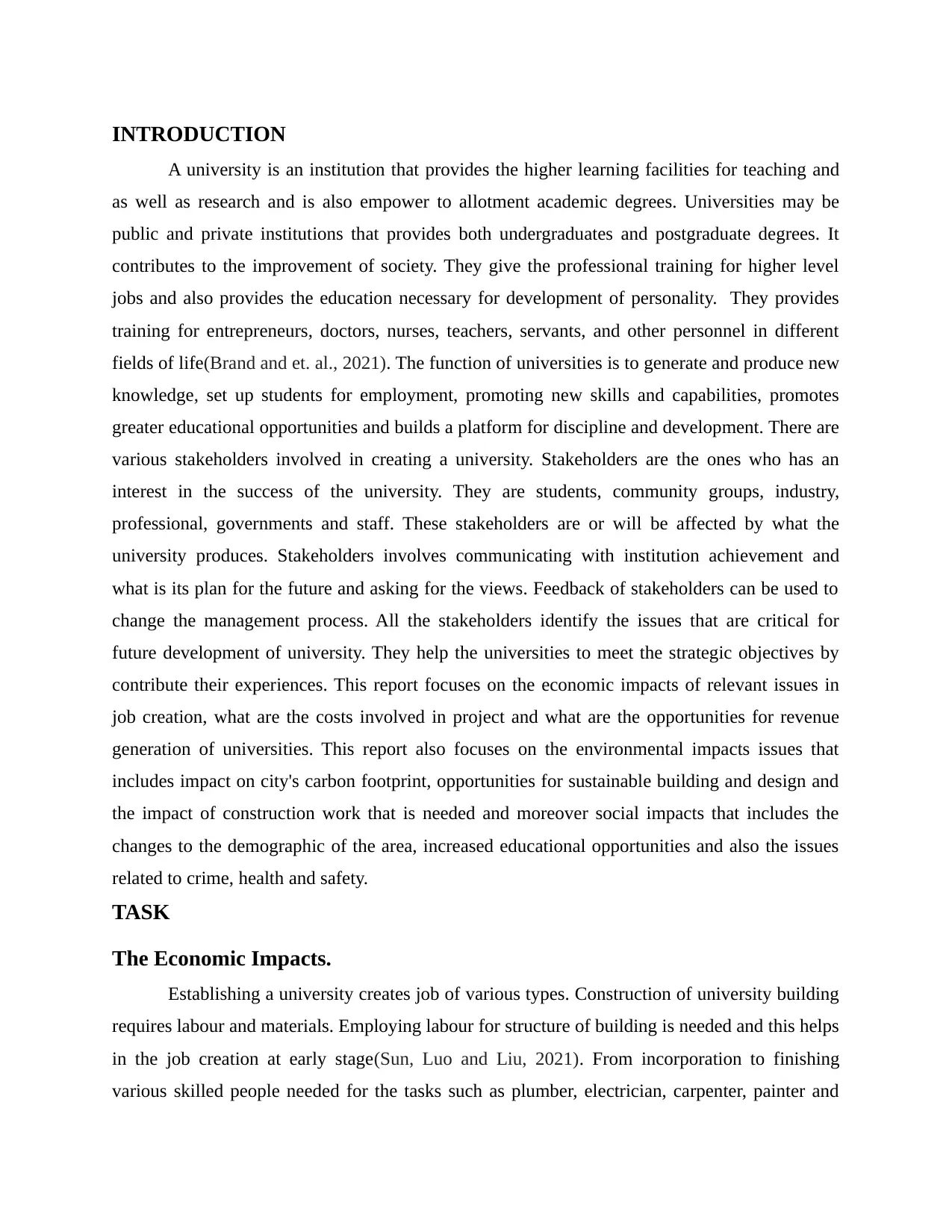
INTRODUCTION
A university is an institution that provides the higher learning facilities for teaching and
as well as research and is also empower to allotment academic degrees. Universities may be
public and private institutions that provides both undergraduates and postgraduate degrees. It
contributes to the improvement of society. They give the professional training for higher level
jobs and also provides the education necessary for development of personality. They provides
training for entrepreneurs, doctors, nurses, teachers, servants, and other personnel in different
fields of life(Brand and et. al., 2021). The function of universities is to generate and produce new
knowledge, set up students for employment, promoting new skills and capabilities, promotes
greater educational opportunities and builds a platform for discipline and development. There are
various stakeholders involved in creating a university. Stakeholders are the ones who has an
interest in the success of the university. They are students, community groups, industry,
professional, governments and staff. These stakeholders are or will be affected by what the
university produces. Stakeholders involves communicating with institution achievement and
what is its plan for the future and asking for the views. Feedback of stakeholders can be used to
change the management process. All the stakeholders identify the issues that are critical for
future development of university. They help the universities to meet the strategic objectives by
contribute their experiences. This report focuses on the economic impacts of relevant issues in
job creation, what are the costs involved in project and what are the opportunities for revenue
generation of universities. This report also focuses on the environmental impacts issues that
includes impact on city's carbon footprint, opportunities for sustainable building and design and
the impact of construction work that is needed and moreover social impacts that includes the
changes to the demographic of the area, increased educational opportunities and also the issues
related to crime, health and safety.
TASK
The Economic Impacts.
Establishing a university creates job of various types. Construction of university building
requires labour and materials. Employing labour for structure of building is needed and this helps
in the job creation at early stage(Sun, Luo and Liu, 2021). From incorporation to finishing
various skilled people needed for the tasks such as plumber, electrician, carpenter, painter and
A university is an institution that provides the higher learning facilities for teaching and
as well as research and is also empower to allotment academic degrees. Universities may be
public and private institutions that provides both undergraduates and postgraduate degrees. It
contributes to the improvement of society. They give the professional training for higher level
jobs and also provides the education necessary for development of personality. They provides
training for entrepreneurs, doctors, nurses, teachers, servants, and other personnel in different
fields of life(Brand and et. al., 2021). The function of universities is to generate and produce new
knowledge, set up students for employment, promoting new skills and capabilities, promotes
greater educational opportunities and builds a platform for discipline and development. There are
various stakeholders involved in creating a university. Stakeholders are the ones who has an
interest in the success of the university. They are students, community groups, industry,
professional, governments and staff. These stakeholders are or will be affected by what the
university produces. Stakeholders involves communicating with institution achievement and
what is its plan for the future and asking for the views. Feedback of stakeholders can be used to
change the management process. All the stakeholders identify the issues that are critical for
future development of university. They help the universities to meet the strategic objectives by
contribute their experiences. This report focuses on the economic impacts of relevant issues in
job creation, what are the costs involved in project and what are the opportunities for revenue
generation of universities. This report also focuses on the environmental impacts issues that
includes impact on city's carbon footprint, opportunities for sustainable building and design and
the impact of construction work that is needed and moreover social impacts that includes the
changes to the demographic of the area, increased educational opportunities and also the issues
related to crime, health and safety.
TASK
The Economic Impacts.
Establishing a university creates job of various types. Construction of university building
requires labour and materials. Employing labour for structure of building is needed and this helps
in the job creation at early stage(Sun, Luo and Liu, 2021). From incorporation to finishing
various skilled people needed for the tasks such as plumber, electrician, carpenter, painter and
⊘ This is a preview!⊘
Do you want full access?
Subscribe today to unlock all pages.

Trusted by 1+ million students worldwide
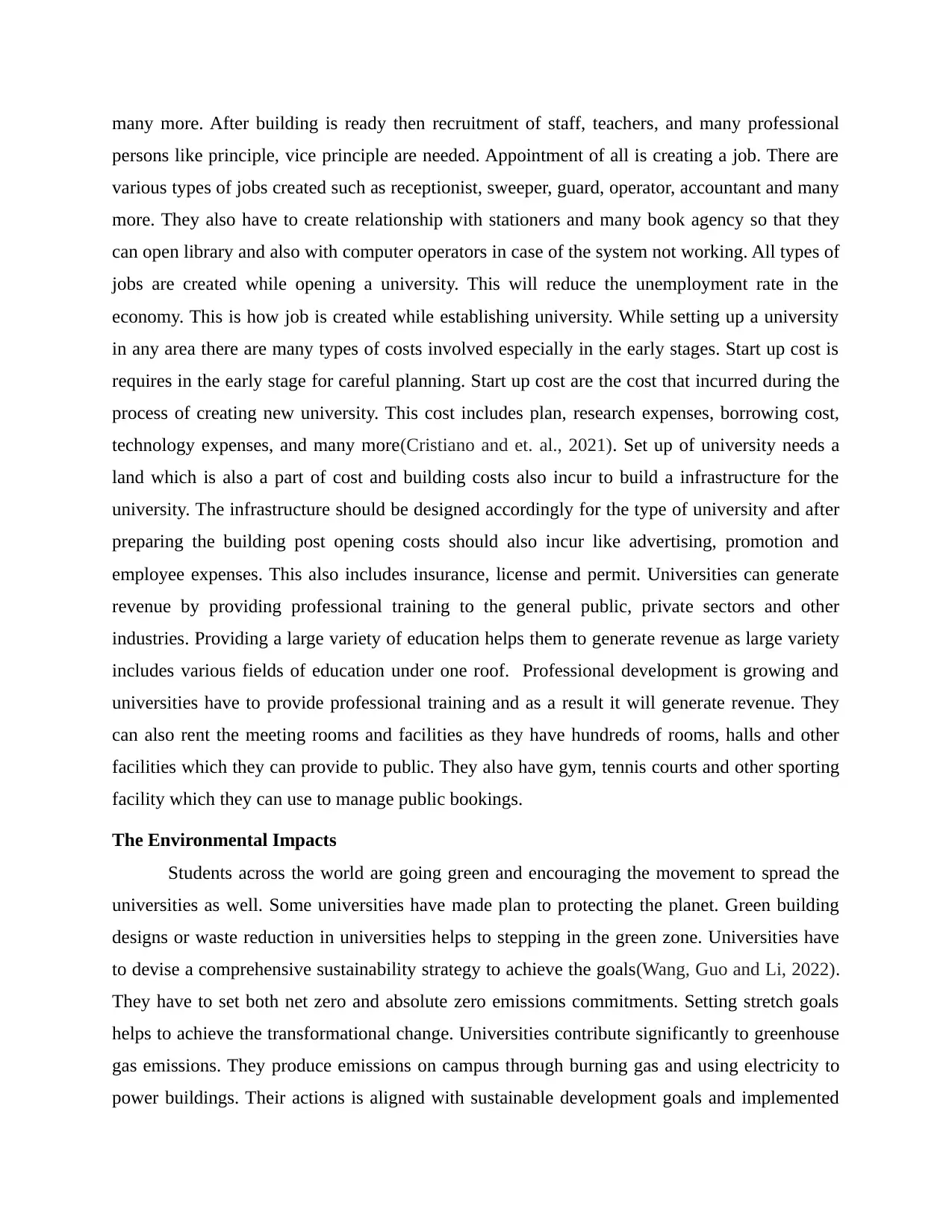
many more. After building is ready then recruitment of staff, teachers, and many professional
persons like principle, vice principle are needed. Appointment of all is creating a job. There are
various types of jobs created such as receptionist, sweeper, guard, operator, accountant and many
more. They also have to create relationship with stationers and many book agency so that they
can open library and also with computer operators in case of the system not working. All types of
jobs are created while opening a university. This will reduce the unemployment rate in the
economy. This is how job is created while establishing university. While setting up a university
in any area there are many types of costs involved especially in the early stages. Start up cost is
requires in the early stage for careful planning. Start up cost are the cost that incurred during the
process of creating new university. This cost includes plan, research expenses, borrowing cost,
technology expenses, and many more(Cristiano and et. al., 2021). Set up of university needs a
land which is also a part of cost and building costs also incur to build a infrastructure for the
university. The infrastructure should be designed accordingly for the type of university and after
preparing the building post opening costs should also incur like advertising, promotion and
employee expenses. This also includes insurance, license and permit. Universities can generate
revenue by providing professional training to the general public, private sectors and other
industries. Providing a large variety of education helps them to generate revenue as large variety
includes various fields of education under one roof. Professional development is growing and
universities have to provide professional training and as a result it will generate revenue. They
can also rent the meeting rooms and facilities as they have hundreds of rooms, halls and other
facilities which they can provide to public. They also have gym, tennis courts and other sporting
facility which they can use to manage public bookings.
The Environmental Impacts
Students across the world are going green and encouraging the movement to spread the
universities as well. Some universities have made plan to protecting the planet. Green building
designs or waste reduction in universities helps to stepping in the green zone. Universities have
to devise a comprehensive sustainability strategy to achieve the goals(Wang, Guo and Li, 2022).
They have to set both net zero and absolute zero emissions commitments. Setting stretch goals
helps to achieve the transformational change. Universities contribute significantly to greenhouse
gas emissions. They produce emissions on campus through burning gas and using electricity to
power buildings. Their actions is aligned with sustainable development goals and implemented
persons like principle, vice principle are needed. Appointment of all is creating a job. There are
various types of jobs created such as receptionist, sweeper, guard, operator, accountant and many
more. They also have to create relationship with stationers and many book agency so that they
can open library and also with computer operators in case of the system not working. All types of
jobs are created while opening a university. This will reduce the unemployment rate in the
economy. This is how job is created while establishing university. While setting up a university
in any area there are many types of costs involved especially in the early stages. Start up cost is
requires in the early stage for careful planning. Start up cost are the cost that incurred during the
process of creating new university. This cost includes plan, research expenses, borrowing cost,
technology expenses, and many more(Cristiano and et. al., 2021). Set up of university needs a
land which is also a part of cost and building costs also incur to build a infrastructure for the
university. The infrastructure should be designed accordingly for the type of university and after
preparing the building post opening costs should also incur like advertising, promotion and
employee expenses. This also includes insurance, license and permit. Universities can generate
revenue by providing professional training to the general public, private sectors and other
industries. Providing a large variety of education helps them to generate revenue as large variety
includes various fields of education under one roof. Professional development is growing and
universities have to provide professional training and as a result it will generate revenue. They
can also rent the meeting rooms and facilities as they have hundreds of rooms, halls and other
facilities which they can provide to public. They also have gym, tennis courts and other sporting
facility which they can use to manage public bookings.
The Environmental Impacts
Students across the world are going green and encouraging the movement to spread the
universities as well. Some universities have made plan to protecting the planet. Green building
designs or waste reduction in universities helps to stepping in the green zone. Universities have
to devise a comprehensive sustainability strategy to achieve the goals(Wang, Guo and Li, 2022).
They have to set both net zero and absolute zero emissions commitments. Setting stretch goals
helps to achieve the transformational change. Universities contribute significantly to greenhouse
gas emissions. They produce emissions on campus through burning gas and using electricity to
power buildings. Their actions is aligned with sustainable development goals and implemented
Paraphrase This Document
Need a fresh take? Get an instant paraphrase of this document with our AI Paraphraser
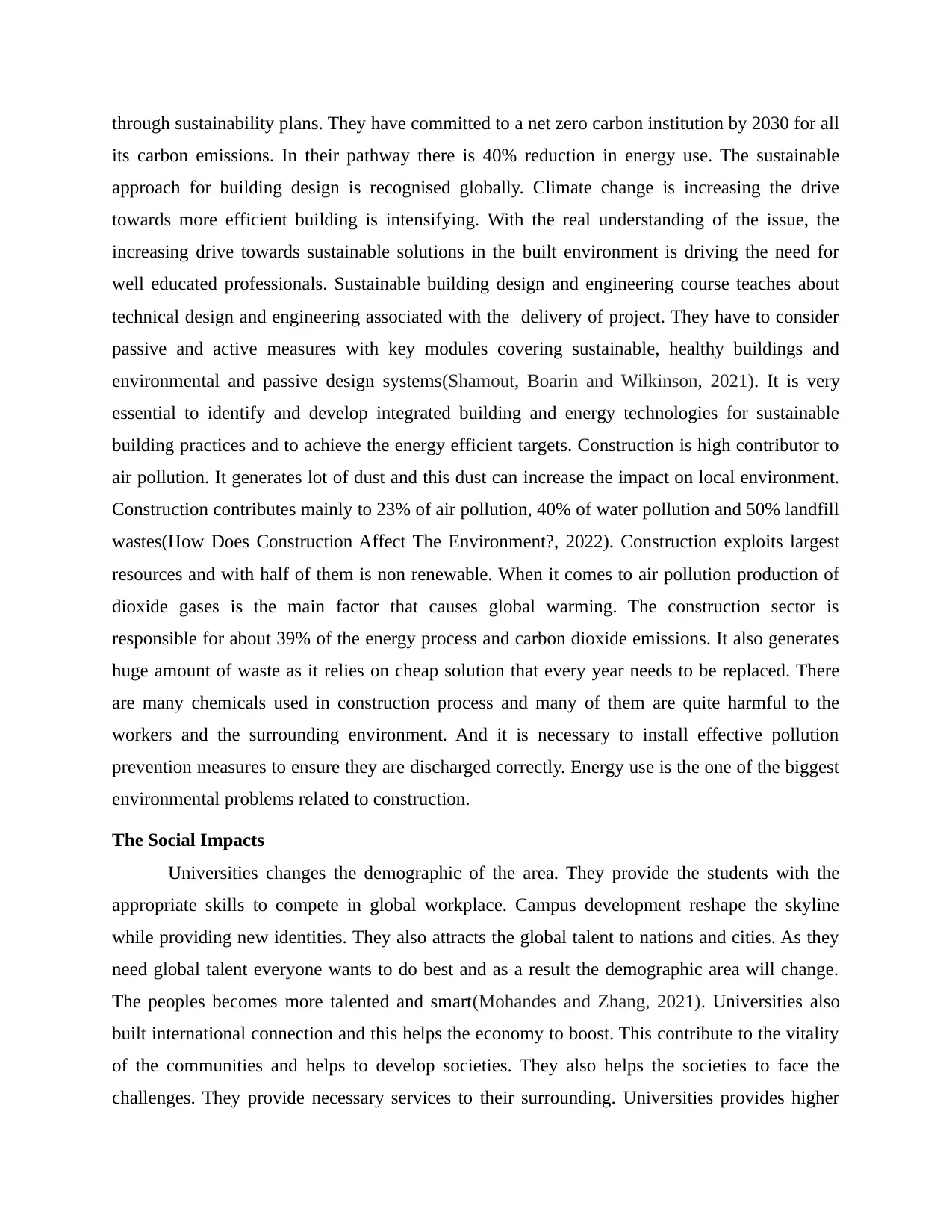
through sustainability plans. They have committed to a net zero carbon institution by 2030 for all
its carbon emissions. In their pathway there is 40% reduction in energy use. The sustainable
approach for building design is recognised globally. Climate change is increasing the drive
towards more efficient building is intensifying. With the real understanding of the issue, the
increasing drive towards sustainable solutions in the built environment is driving the need for
well educated professionals. Sustainable building design and engineering course teaches about
technical design and engineering associated with the delivery of project. They have to consider
passive and active measures with key modules covering sustainable, healthy buildings and
environmental and passive design systems(Shamout, Boarin and Wilkinson, 2021). It is very
essential to identify and develop integrated building and energy technologies for sustainable
building practices and to achieve the energy efficient targets. Construction is high contributor to
air pollution. It generates lot of dust and this dust can increase the impact on local environment.
Construction contributes mainly to 23% of air pollution, 40% of water pollution and 50% landfill
wastes(How Does Construction Affect The Environment?, 2022). Construction exploits largest
resources and with half of them is non renewable. When it comes to air pollution production of
dioxide gases is the main factor that causes global warming. The construction sector is
responsible for about 39% of the energy process and carbon dioxide emissions. It also generates
huge amount of waste as it relies on cheap solution that every year needs to be replaced. There
are many chemicals used in construction process and many of them are quite harmful to the
workers and the surrounding environment. And it is necessary to install effective pollution
prevention measures to ensure they are discharged correctly. Energy use is the one of the biggest
environmental problems related to construction.
The Social Impacts
Universities changes the demographic of the area. They provide the students with the
appropriate skills to compete in global workplace. Campus development reshape the skyline
while providing new identities. They also attracts the global talent to nations and cities. As they
need global talent everyone wants to do best and as a result the demographic area will change.
The peoples becomes more talented and smart(Mohandes and Zhang, 2021). Universities also
built international connection and this helps the economy to boost. This contribute to the vitality
of the communities and helps to develop societies. They also helps the societies to face the
challenges. They provide necessary services to their surrounding. Universities provides higher
its carbon emissions. In their pathway there is 40% reduction in energy use. The sustainable
approach for building design is recognised globally. Climate change is increasing the drive
towards more efficient building is intensifying. With the real understanding of the issue, the
increasing drive towards sustainable solutions in the built environment is driving the need for
well educated professionals. Sustainable building design and engineering course teaches about
technical design and engineering associated with the delivery of project. They have to consider
passive and active measures with key modules covering sustainable, healthy buildings and
environmental and passive design systems(Shamout, Boarin and Wilkinson, 2021). It is very
essential to identify and develop integrated building and energy technologies for sustainable
building practices and to achieve the energy efficient targets. Construction is high contributor to
air pollution. It generates lot of dust and this dust can increase the impact on local environment.
Construction contributes mainly to 23% of air pollution, 40% of water pollution and 50% landfill
wastes(How Does Construction Affect The Environment?, 2022). Construction exploits largest
resources and with half of them is non renewable. When it comes to air pollution production of
dioxide gases is the main factor that causes global warming. The construction sector is
responsible for about 39% of the energy process and carbon dioxide emissions. It also generates
huge amount of waste as it relies on cheap solution that every year needs to be replaced. There
are many chemicals used in construction process and many of them are quite harmful to the
workers and the surrounding environment. And it is necessary to install effective pollution
prevention measures to ensure they are discharged correctly. Energy use is the one of the biggest
environmental problems related to construction.
The Social Impacts
Universities changes the demographic of the area. They provide the students with the
appropriate skills to compete in global workplace. Campus development reshape the skyline
while providing new identities. They also attracts the global talent to nations and cities. As they
need global talent everyone wants to do best and as a result the demographic area will change.
The peoples becomes more talented and smart(Mohandes and Zhang, 2021). Universities also
built international connection and this helps the economy to boost. This contribute to the vitality
of the communities and helps to develop societies. They also helps the societies to face the
challenges. They provide necessary services to their surrounding. Universities provides higher
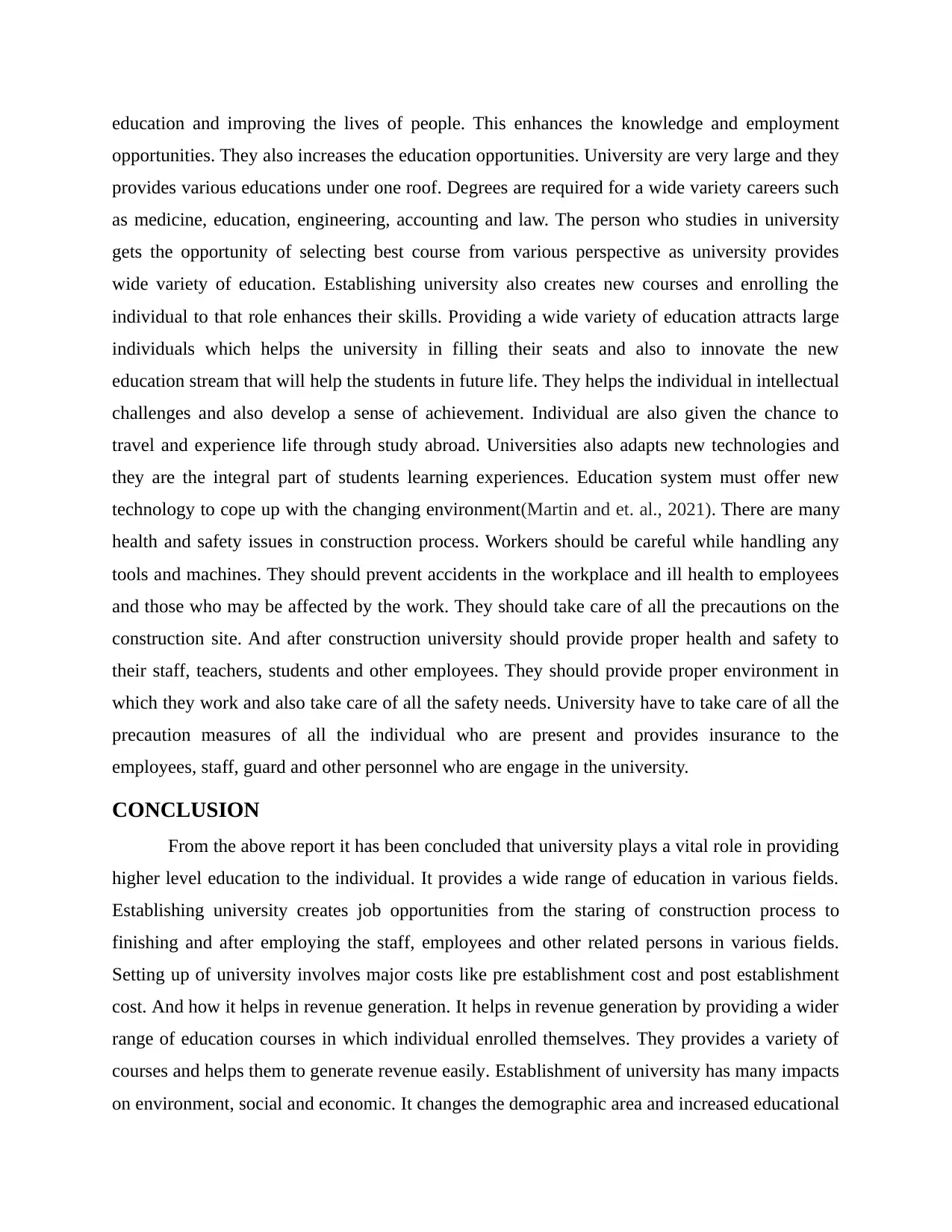
education and improving the lives of people. This enhances the knowledge and employment
opportunities. They also increases the education opportunities. University are very large and they
provides various educations under one roof. Degrees are required for a wide variety careers such
as medicine, education, engineering, accounting and law. The person who studies in university
gets the opportunity of selecting best course from various perspective as university provides
wide variety of education. Establishing university also creates new courses and enrolling the
individual to that role enhances their skills. Providing a wide variety of education attracts large
individuals which helps the university in filling their seats and also to innovate the new
education stream that will help the students in future life. They helps the individual in intellectual
challenges and also develop a sense of achievement. Individual are also given the chance to
travel and experience life through study abroad. Universities also adapts new technologies and
they are the integral part of students learning experiences. Education system must offer new
technology to cope up with the changing environment(Martin and et. al., 2021). There are many
health and safety issues in construction process. Workers should be careful while handling any
tools and machines. They should prevent accidents in the workplace and ill health to employees
and those who may be affected by the work. They should take care of all the precautions on the
construction site. And after construction university should provide proper health and safety to
their staff, teachers, students and other employees. They should provide proper environment in
which they work and also take care of all the safety needs. University have to take care of all the
precaution measures of all the individual who are present and provides insurance to the
employees, staff, guard and other personnel who are engage in the university.
CONCLUSION
From the above report it has been concluded that university plays a vital role in providing
higher level education to the individual. It provides a wide range of education in various fields.
Establishing university creates job opportunities from the staring of construction process to
finishing and after employing the staff, employees and other related persons in various fields.
Setting up of university involves major costs like pre establishment cost and post establishment
cost. And how it helps in revenue generation. It helps in revenue generation by providing a wider
range of education courses in which individual enrolled themselves. They provides a variety of
courses and helps them to generate revenue easily. Establishment of university has many impacts
on environment, social and economic. It changes the demographic area and increased educational
opportunities. They also increases the education opportunities. University are very large and they
provides various educations under one roof. Degrees are required for a wide variety careers such
as medicine, education, engineering, accounting and law. The person who studies in university
gets the opportunity of selecting best course from various perspective as university provides
wide variety of education. Establishing university also creates new courses and enrolling the
individual to that role enhances their skills. Providing a wide variety of education attracts large
individuals which helps the university in filling their seats and also to innovate the new
education stream that will help the students in future life. They helps the individual in intellectual
challenges and also develop a sense of achievement. Individual are also given the chance to
travel and experience life through study abroad. Universities also adapts new technologies and
they are the integral part of students learning experiences. Education system must offer new
technology to cope up with the changing environment(Martin and et. al., 2021). There are many
health and safety issues in construction process. Workers should be careful while handling any
tools and machines. They should prevent accidents in the workplace and ill health to employees
and those who may be affected by the work. They should take care of all the precautions on the
construction site. And after construction university should provide proper health and safety to
their staff, teachers, students and other employees. They should provide proper environment in
which they work and also take care of all the safety needs. University have to take care of all the
precaution measures of all the individual who are present and provides insurance to the
employees, staff, guard and other personnel who are engage in the university.
CONCLUSION
From the above report it has been concluded that university plays a vital role in providing
higher level education to the individual. It provides a wide range of education in various fields.
Establishing university creates job opportunities from the staring of construction process to
finishing and after employing the staff, employees and other related persons in various fields.
Setting up of university involves major costs like pre establishment cost and post establishment
cost. And how it helps in revenue generation. It helps in revenue generation by providing a wider
range of education courses in which individual enrolled themselves. They provides a variety of
courses and helps them to generate revenue easily. Establishment of university has many impacts
on environment, social and economic. It changes the demographic area and increased educational
⊘ This is a preview!⊘
Do you want full access?
Subscribe today to unlock all pages.

Trusted by 1+ million students worldwide
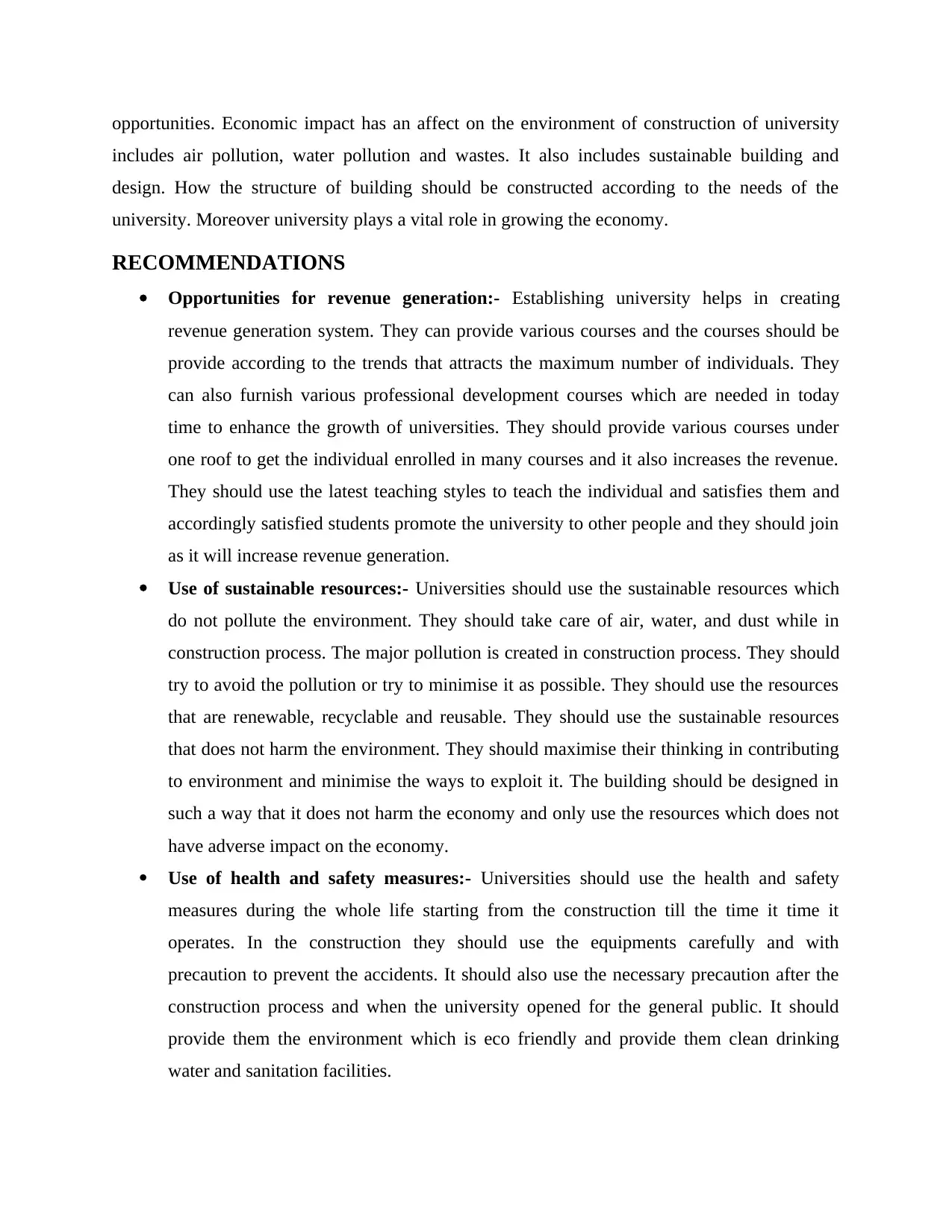
opportunities. Economic impact has an affect on the environment of construction of university
includes air pollution, water pollution and wastes. It also includes sustainable building and
design. How the structure of building should be constructed according to the needs of the
university. Moreover university plays a vital role in growing the economy.
RECOMMENDATIONS
Opportunities for revenue generation:- Establishing university helps in creating
revenue generation system. They can provide various courses and the courses should be
provide according to the trends that attracts the maximum number of individuals. They
can also furnish various professional development courses which are needed in today
time to enhance the growth of universities. They should provide various courses under
one roof to get the individual enrolled in many courses and it also increases the revenue.
They should use the latest teaching styles to teach the individual and satisfies them and
accordingly satisfied students promote the university to other people and they should join
as it will increase revenue generation.
Use of sustainable resources:- Universities should use the sustainable resources which
do not pollute the environment. They should take care of air, water, and dust while in
construction process. The major pollution is created in construction process. They should
try to avoid the pollution or try to minimise it as possible. They should use the resources
that are renewable, recyclable and reusable. They should use the sustainable resources
that does not harm the environment. They should maximise their thinking in contributing
to environment and minimise the ways to exploit it. The building should be designed in
such a way that it does not harm the economy and only use the resources which does not
have adverse impact on the economy.
Use of health and safety measures:- Universities should use the health and safety
measures during the whole life starting from the construction till the time it time it
operates. In the construction they should use the equipments carefully and with
precaution to prevent the accidents. It should also use the necessary precaution after the
construction process and when the university opened for the general public. It should
provide them the environment which is eco friendly and provide them clean drinking
water and sanitation facilities.
includes air pollution, water pollution and wastes. It also includes sustainable building and
design. How the structure of building should be constructed according to the needs of the
university. Moreover university plays a vital role in growing the economy.
RECOMMENDATIONS
Opportunities for revenue generation:- Establishing university helps in creating
revenue generation system. They can provide various courses and the courses should be
provide according to the trends that attracts the maximum number of individuals. They
can also furnish various professional development courses which are needed in today
time to enhance the growth of universities. They should provide various courses under
one roof to get the individual enrolled in many courses and it also increases the revenue.
They should use the latest teaching styles to teach the individual and satisfies them and
accordingly satisfied students promote the university to other people and they should join
as it will increase revenue generation.
Use of sustainable resources:- Universities should use the sustainable resources which
do not pollute the environment. They should take care of air, water, and dust while in
construction process. The major pollution is created in construction process. They should
try to avoid the pollution or try to minimise it as possible. They should use the resources
that are renewable, recyclable and reusable. They should use the sustainable resources
that does not harm the environment. They should maximise their thinking in contributing
to environment and minimise the ways to exploit it. The building should be designed in
such a way that it does not harm the economy and only use the resources which does not
have adverse impact on the economy.
Use of health and safety measures:- Universities should use the health and safety
measures during the whole life starting from the construction till the time it time it
operates. In the construction they should use the equipments carefully and with
precaution to prevent the accidents. It should also use the necessary precaution after the
construction process and when the university opened for the general public. It should
provide them the environment which is eco friendly and provide them clean drinking
water and sanitation facilities.
Paraphrase This Document
Need a fresh take? Get an instant paraphrase of this document with our AI Paraphraser
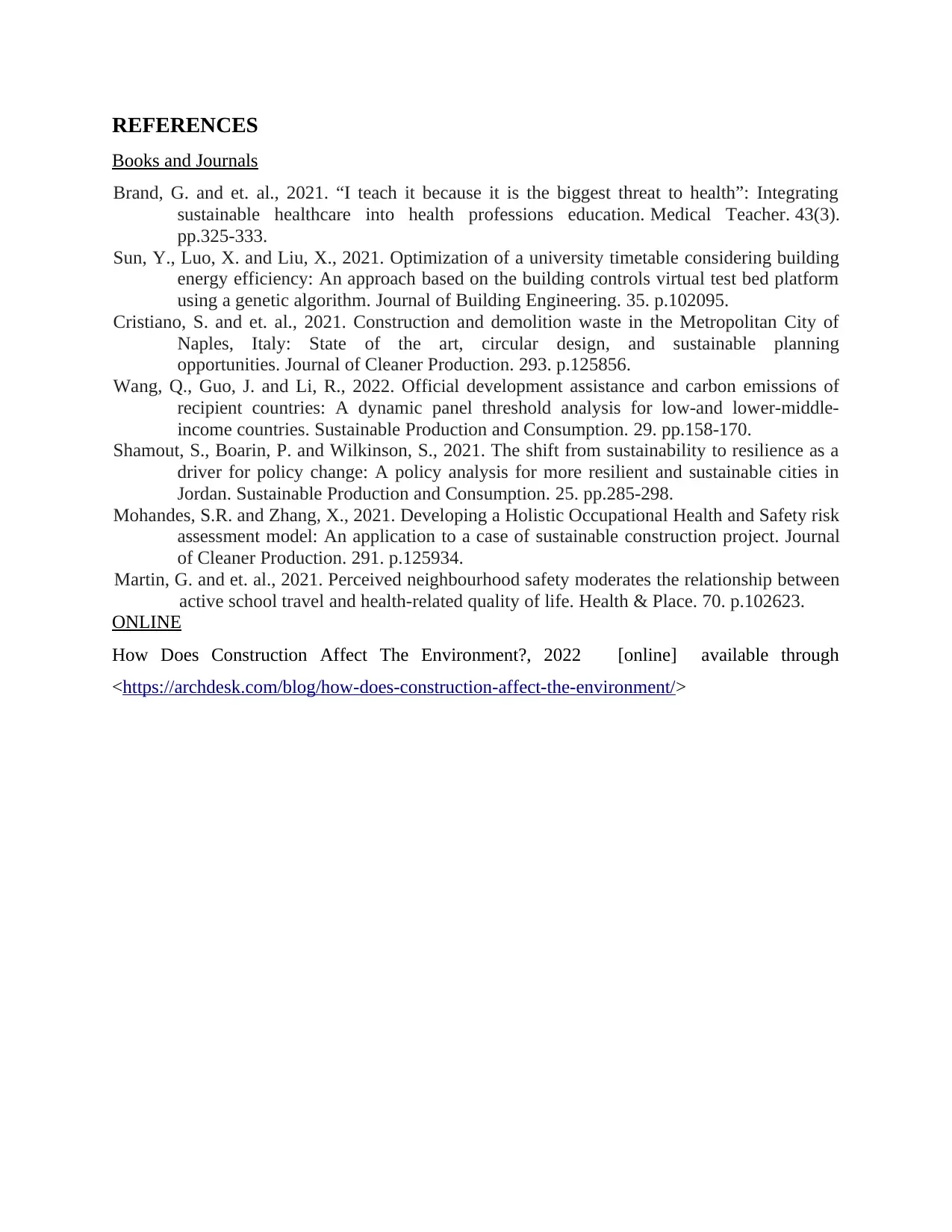
REFERENCES
Books and Journals
Brand, G. and et. al., 2021. “I teach it because it is the biggest threat to health”: Integrating
sustainable healthcare into health professions education. Medical Teacher. 43(3).
pp.325-333.
Sun, Y., Luo, X. and Liu, X., 2021. Optimization of a university timetable considering building
energy efficiency: An approach based on the building controls virtual test bed platform
using a genetic algorithm. Journal of Building Engineering. 35. p.102095.
Cristiano, S. and et. al., 2021. Construction and demolition waste in the Metropolitan City of
Naples, Italy: State of the art, circular design, and sustainable planning
opportunities. Journal of Cleaner Production. 293. p.125856.
Wang, Q., Guo, J. and Li, R., 2022. Official development assistance and carbon emissions of
recipient countries: A dynamic panel threshold analysis for low-and lower-middle-
income countries. Sustainable Production and Consumption. 29. pp.158-170.
Shamout, S., Boarin, P. and Wilkinson, S., 2021. The shift from sustainability to resilience as a
driver for policy change: A policy analysis for more resilient and sustainable cities in
Jordan. Sustainable Production and Consumption. 25. pp.285-298.
Mohandes, S.R. and Zhang, X., 2021. Developing a Holistic Occupational Health and Safety risk
assessment model: An application to a case of sustainable construction project. Journal
of Cleaner Production. 291. p.125934.
Martin, G. and et. al., 2021. Perceived neighbourhood safety moderates the relationship between
active school travel and health-related quality of life. Health & Place. 70. p.102623.
ONLINE
How Does Construction Affect The Environment?, 2022 [online] available through
<https://archdesk.com/blog/how-does-construction-affect-the-environment/>
Books and Journals
Brand, G. and et. al., 2021. “I teach it because it is the biggest threat to health”: Integrating
sustainable healthcare into health professions education. Medical Teacher. 43(3).
pp.325-333.
Sun, Y., Luo, X. and Liu, X., 2021. Optimization of a university timetable considering building
energy efficiency: An approach based on the building controls virtual test bed platform
using a genetic algorithm. Journal of Building Engineering. 35. p.102095.
Cristiano, S. and et. al., 2021. Construction and demolition waste in the Metropolitan City of
Naples, Italy: State of the art, circular design, and sustainable planning
opportunities. Journal of Cleaner Production. 293. p.125856.
Wang, Q., Guo, J. and Li, R., 2022. Official development assistance and carbon emissions of
recipient countries: A dynamic panel threshold analysis for low-and lower-middle-
income countries. Sustainable Production and Consumption. 29. pp.158-170.
Shamout, S., Boarin, P. and Wilkinson, S., 2021. The shift from sustainability to resilience as a
driver for policy change: A policy analysis for more resilient and sustainable cities in
Jordan. Sustainable Production and Consumption. 25. pp.285-298.
Mohandes, S.R. and Zhang, X., 2021. Developing a Holistic Occupational Health and Safety risk
assessment model: An application to a case of sustainable construction project. Journal
of Cleaner Production. 291. p.125934.
Martin, G. and et. al., 2021. Perceived neighbourhood safety moderates the relationship between
active school travel and health-related quality of life. Health & Place. 70. p.102623.
ONLINE
How Does Construction Affect The Environment?, 2022 [online] available through
<https://archdesk.com/blog/how-does-construction-affect-the-environment/>
1 out of 8
Related Documents
Your All-in-One AI-Powered Toolkit for Academic Success.
+13062052269
info@desklib.com
Available 24*7 on WhatsApp / Email
![[object Object]](/_next/static/media/star-bottom.7253800d.svg)
Unlock your academic potential
Copyright © 2020–2025 A2Z Services. All Rights Reserved. Developed and managed by ZUCOL.



